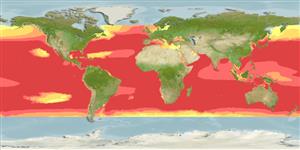Common names from other countries
Environment: milieu / climate zone / depth range / distribution range
ນິເວດວິທະຍາ
ສັດທະເລ; ປາທີ່ມີການເຄື່ອນຍ້າຍໃນສະເພາະມາະຫາສະມຸດ (Ref. 51243); ລະດັບຄວາມເລິກ 0 - 600 m (Ref. 168). Subtropical; 10°C - 25°C (Ref. 168); 60°N - 50°S, 180°W - 180°E
Cosmopolitan in tropical and temperate waters of all oceans including the Mediterranean Sea but not at the surface between 10°N and 10°S. Western Pacific: range extend in a broad band between 40°N and 40°S (Ref. 9684). Often confused with juvenile Thunnus obesus which also have very long pectorals but with rounded tips. Highly migratory species.
Length at first maturity / ຂະໜາດ / ນ້ຳໜັກ / Age
Maturity: Lm 85.2, range 83 - ? cm
Max length : 140 cm FL ຕົວຜູ້/ບໍ່ມີເພດ; (Ref. 3669); common length : 100.0 cm FL ຕົວຜູ້/ບໍ່ມີເພດ; (Ref. 9684); ນ້ຳໜັກສູງສຸດທີ່ເຄຍຈັດພີມມາ: 60.3 kg (Ref. 40637); ອາຍຸສູງສຸດທີ່ເຄຍລາຍງານມາ: 9 ປີ (Ref. 72462)
ຄີ (ໜາມ)ແຂງຢູ່ຫຼັງປາ (ທັງໝົດ) : 11 - 14; ຄີຫຼັງຂອງປາ (ຄີອ່ອນ) (ທັງໝົດ) : 12 - 16; ຄີ(ໜາມ) ແຂງຢູ່ຄີກົ້ນປາ
ກຸ່ມປາກະດູກແຂງ
ຄວາມຖີ່ຂອງກຸ່ມຖ່າຍທອດພັນ
ປາທີ່ມີການເຄື່ອນຍ້າຍຈາກທະເລໄປຫານ້ຳຈືດ ແລະນ້ຳຈືດຫາທະເລ
ປາທີ່ມີການເຄື່ອນຍ້າຍຈາກທະເລແລະໄປໄຂ່ຢູ່ນ້ຳຈືດ
ຄີກົ້ນຂອງປາ
ສັດທີ່ມີກະດູກສັນຫັຼງ
ການຖ່າຍທອດທາງກຳມະພັນຈາກພໍ່ແມ່ຫາລູກ: 0; ຄີກົ້ນຂອງປາ: 11 - 16. Anterior spines much higher than posterior spines giving the fin a strongly concave outline. Interpelvic process small and bifid. Body with very small scales. Pectoral fins remarkably long, about 30% of fork length or longer in 50 cm or longer fish. Ventral surface of liver striated and the central lobe is largest.
An epipelagic and mesopelagic, oceanic species, abundant in surface waters of 15.6° to 19.4°C; deeper swimming, large albacore are found in waters of 13.5° to 25.2°C; temperatures as low as 9.5°C may be tolerated for short periods (Ref. 168). Known to concentrate along thermal discontinuities (Ref. 168). Form mixed schools with skipjack tuna (Katsuwonus pelamis), yellowfin tuna (Thunnus albacares) and bluefin tuna (T. maccoyii), schools may be associated with floating objects, including sargassum weeds (Ref. 168). Feed on fishes, crustaceans and squids. Eggs and larvae are pelagic (Ref. 6769). Sexual maturity reached at 90 cm (Ref. 36731). Highly appreciated and marketed fresh, smoked, deep frozen or canned. Eaten steamed, broiled, fried and microwaved (Ref. 9987). Also Ref. 1762, 1798, 1804.
Angling: Largely caught offshore, where the waters are mild and blue. Albacore favor those areas where cooler water interfaces with warmer water. They are caught with live of dead baitfish such as mullet, sauries, squid, herring, anchovies, sardines, and other small fish. Albacore strike hard and make powerful runs (Ref. 84357).
The sex ratio in catches is about 1:1 for immature individuals, but males predominate among mature fishes, which is possibly due to both differential mortality of sexes and differential growth rate after maturity.
Collette, B.B. and C.E. Nauen, 1983. FAO Species Catalogue. Vol. 2. Scombrids of the world. An annotated and illustrated catalogue of tunas, mackerels, bonitos and related species known to date. Rome: FAO. FAO Fish. Synop. 125(2):137 p. (Ref. 168)
IUCN Red List Status (Ref. 130435)
CITES (Ref. 128078)
Not Evaluated
Threat to humans
Harmless
Human uses
ການປະມົງ: ທີ່ມີການຄ້າສູງ; ຊະນິດປາທີ່ຖືກນຳໃຊ້ເຂົ້າໃນການຫາເພື່ອເປັນເກມກິລາ: ແມ່ນ
ເຄື່ອງມື
Special reports
Download XML
ແຫຼ່ງອີນເຕີເນັດ
Estimates based on models
Preferred temperature (Ref.
115969): 8.8 - 21.2, mean 15.1 (based on 784 cells).
Phylogenetic diversity index (Ref.
82804): PD
50 = 0.5039 [Uniqueness, from 0.5 = low to 2.0 = high].
Bayesian length-weight: a=0.01738 (0.01428 - 0.02115), b=3.01 (2.97 - 3.05), in cm Total Length, based on LWR estimates for this species (Ref.
93245).
ຊັ້ນເຂດຮ້ອນ (Ref.
69278): 4.3 ±0.2 se; based on diet studies.
ຄວາມຢືດຢຸ່ນ (Ref.
120179): ຂະໜາດກາງ, ປະຊາກອນຕຳ່ສຸດທີ່ໃຊ້ເວລາສອງເທົ່າ 1.4 - 4.4 ປີ (K=0.13-0.18; tm=4-6; tmax=10; Fec=2 million).
Prior r = 0.43, 95% CL = 0.28 - 0.64, Based on 15 full stock assessments.
Fishing Vulnerability (Ref.
59153): High to very high vulnerability (71 of 100).
Climate Vulnerability (Ref.
125649): Moderate vulnerability (42 of 100).
